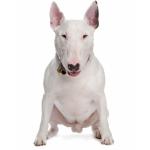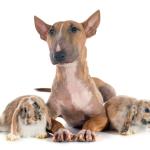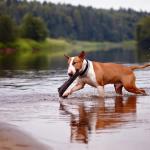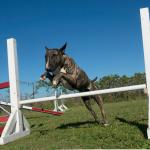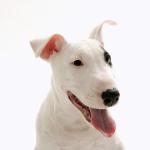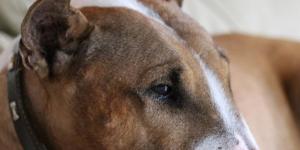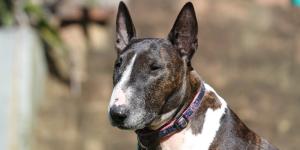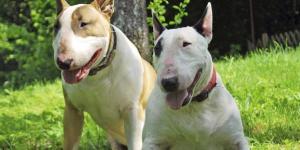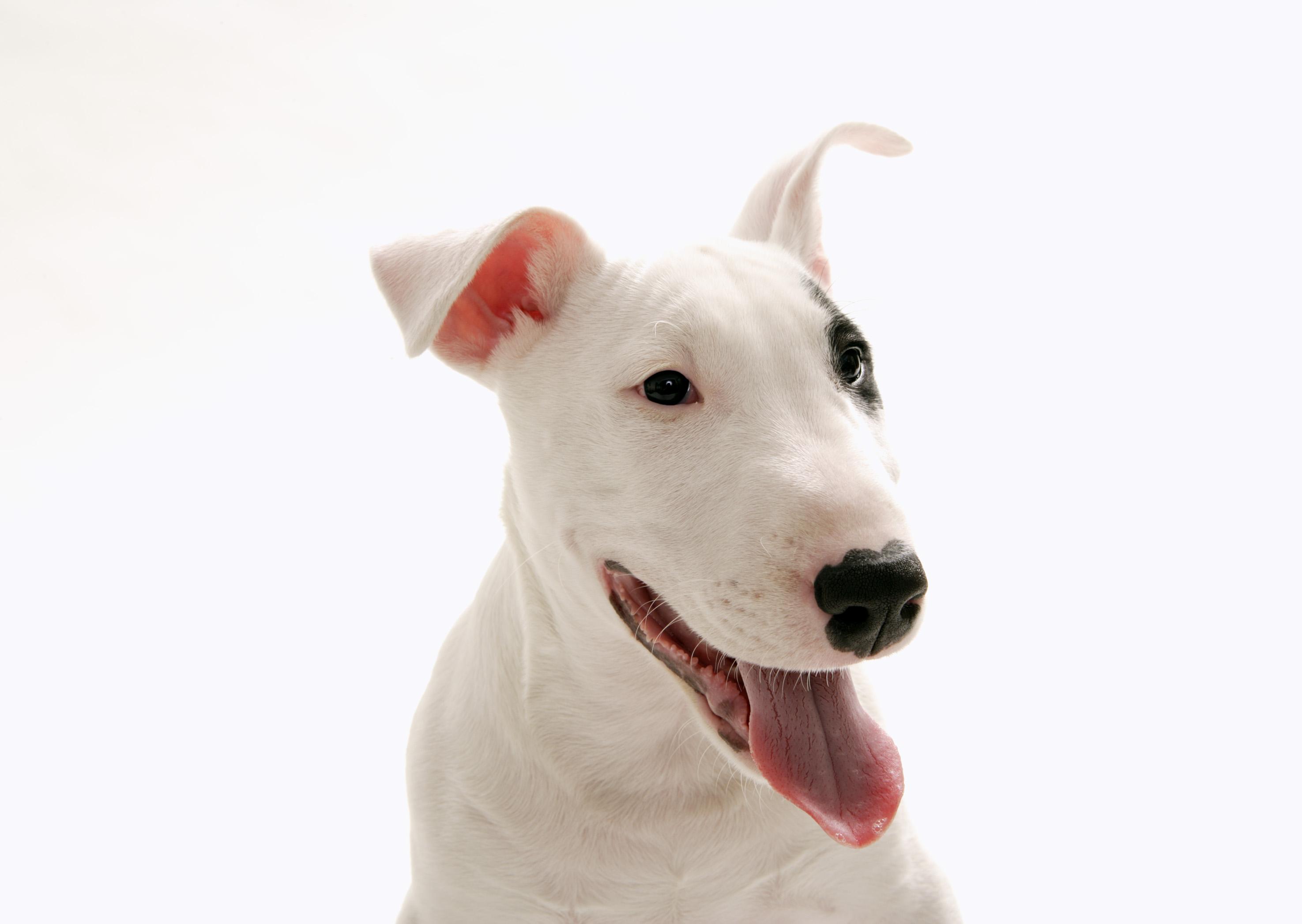English Bull Terrier
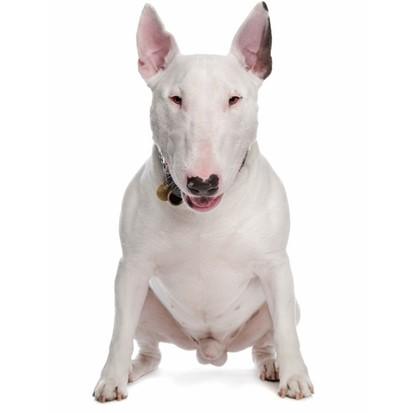
The English Bull Terrier is a breed of dog known for the unique shape of its head and its small triangular shaped ears. There are two variants of the breed: the Bull Terrier and the miniature Bull Terrier. They were developed in Britain as a both a fighting and show dog.
If you are thinking of adopting a puppy or adult, it is important that you inform yourself about their character, their physical characteristics and the education that they need for proper training. The English Bull Terrier is a fantastic dog in many ways, find out everything about this breed here at AnimalWised.
- Europe
- United Kingdom
- Group III
- 5-14
- 14-18
- 18-22
- 22-27
- 27-31
- More than 31
- 2-7
- 7-22
- 22-55
- 55-100
- 100-220
- 8-10
- 10-12
- 12-14
- 15-20
- Low
- Meidum
- High
Origin of an English Bull Terrier
Like the history of the other bull-type terriers, its origin is related to dog-bull fights and dog fights. When bull fights were banned by law in Great Britain, back in 1835, crosses were developed between bulldogs and terrier dogs to get lighter but equally tenacious animals able to resist and fight in the new and cruel "sport" of dog fights. This is how the ancestors of the current Bull Terrier emerged, which became known as bull and terrier, due to the crosses involved. These dogs had the combativeness and resistance to pain of a Bulldog and the agility and sagacity of the terrier.
In 1850, James Hinks standardized the breed for the first time, by carrying out selected crossings between white Bull Terriers with other breeds, including the now extinct white English terrier. The dogs bred by Hinks were the pillar of the current breed, and in their time they were already known as Bull Terrier or "the white knights". The breed of that time still had a marked stop and the head was not the egg typical of the current Bull Terrier. It is not known with certainty what breeds were used to achieve this characteristic head and greater elegance of its body, but it is thought that dog breeds such as: the Burgos Retriever, the collie, the greyhound and even the Dalmatian were used.
The first Bull Terrier club was created in England in 1887. In 1888 the first official standard of the breed was published. In 1917 the first modern Bull Terrier was born, with an egg head . His name was "Lord Gladiator" and represents the birth of the race as we know it today.
The Miniature Bull Terrier was developed later, from selective crossings among standard Bull Terrier dogs. Its development had to do with new functions that the breed aimed to fulfill, such as companionship.
Physical characteristics of a English Bull Terrier
The English Bull Terrier is a strong and muscular dog, usually white but it can also be black, red or tabby. Its hair is short and smooth so you will not need to brush excessively. It oval shaped head (naso-frontal depression), ears and triangular shaped eyes offer a totally unique and different physicality compared to other breeds. Sometimes males are more robust than the slight finesse of the females.
Its nose, black and with well-developed nostrils, curves downward at the tip. Its jaws are very powerful. When the English Bull Terrier closes its mouth, the inner face of the upper incisors comes in contact with the outer face of the lower incisors. In this way, the bite closes in like scissors. The Bull Terrier's eyes are black or very dark brown, narrow and triangular. They are arranged obliquely in the skull and have a bright look that expresses decision and intelligence.
Its neck is muscular, long and arched. It does not have a double chin. The short and strong back, connects with a broad and muscular shoulders. The chest is deep and wide. The lower line forms an elegant upward curve from the chest to the abdomen. As in other bull-type terrier, the tail of the Bull Terrier is thick at the base and tapers towards the tip. It is short with a low insertion.
A Bull Terrier's hair is short, rough, tight and has a fine shine. In winter a sub-texture with a soft texture may appear. As for color, although white is usually the most common, it is not the only one. The color of a Bull Terrier can be all white with spots or vice versa.
Character of an English Bull Terrier
An English Bull Terrier, if well educated, has a balanced and affectionate character. They are faithful dogs by nature and really affectionate. They are extremely brave, as they feel a deep sense sense of protection, although this does not mean that they are aggressive dogs. However, being considered a potentially dangerous dog, the use of the muzzle and the belt is recommended in public spaces. It is important to accustom the dog to the muzzle step by step so that he feels comfortable when using it and does not relate it as a punishment.
It is advisable to always supervise children who do not know how to relate to a dog. A tug on your ears can lead to a snarl, so we recommend educating your children so they know how to interact with an English Bull Terrier.
Sometimes these dogs tend to be a bit stubborn therefore, one must actively work work when educating this dog. Castration is highly recommended to achieve a stable adult dog. This race, strongly attached to its owners, suffers a lot with loneliness, so we recommend avoiding adopting this breed if you do not have time to devote to them and all of their needs. It is an excellent watchdog that will always warn you of the arrival of someone at your house.
The Bull Terrier is a loving dog that will socialize without any problem. they are a playful and patient dogs, despite their strong physical bulk and a big jaws. For that reason, one must avoid having this dog around children who are too young. It is not an aggressive dog if it is properly educated, but at certain times it can hurt, unintentionally, especially if it gets excited while playing.
As for contact with other dogs, we must know that they can become reactive and instigated to aggressiveness if they are not properly educated and trained. It is very important to understand that education is fundamental for a dog with voluptuous physical characteristics such as the Bull Terrier. The great bond they grow within the family tends to be displayed through an overprotective nature. If we educate our dog in the right way, we will not have problems related withdogs, pets, children and adults.
Caring for an English Bull Terrier
Its coat is easy to maintain as it is short and easy to clean. In winter it is advisable to put some kind of jacket on this dog, since its short hair will make it prone to tremors and, therefore, physical discomfort. Being a very active dog, we must make sure to offer long and complete walks, including physical exercise if needed and games. Of course, this intense exercise must be controlled in its youth and old age stages to avoid the aforementioned, muscle or growth problems.
Bull Terriers tend to overeat if given the opportunity, so we must control the correct dosage of the food that we are going to give them making sure it is always of high quality. Remember that good feed is not only reflected in the happiness of the dog but also in their health, coat, well-being,and in the fight to avoid obesity.
Educating an English Bull Terrier
It is common that Bull Terriers try to bite everything they find: be it our hands, furniture or household objects. So from puppies one should teach them how to bite using teethes and various toys. The black kong toy, is a very resistant perfect for its powerful jaw.
The next step in the education of a Bull Terrier will be to start with socialization it as a puppy, a process in which we must teach them to relate to other dogs, people and objects. This step is essential so that in the future we can enjoy a sociable adult canine who is not scared of cars, people or bicycles. Everything we can teach this dog at an earlier stage will be beneficial for its future.
Once all the above has been achieved, we will begin with training. For this, we suggest spending about 10 or 15 minutes a day practicing basic commands. It is not about teaching fun tricks, but rather indications that help for yours and the dogs safety. ‘Sit, stay or come’ help to avoid dangerous situations in the future, allowing you as the owner to command the dogs whereabouts when in public spaces.
Beyond that of safety, practicing orders using positive reinforcement is a perfect way to strengthen ones relationship with their dog. It is not advisable in any case to punish or use aggression with an animal, regardless of the breed. Although many people are unaware of this, the stress and anxiety that is produced by punishment is very counterproductive to the welfare of the dog, in addition it can lead to stimulating aggressiveness in the dog instead of eliminating it.
Health of the English Bull Terrier
The most common diseases of the Bull Terrier are the following:
- Deafness
- Ball joint dislocation
- Renal problems
- Heart problems
- Skin problems
In addition to the above, they are sensitive to insect bites and, therefore, should be adequately protected. It is advisable to check your Bull Terrier regularly and make sure they does not suffer any skin problems, as well as carefully stretch their joints to check that they move well. Through active walks they can exercise their muscles, but that does not mean we should them to. Excessive exercise can lead to joint problems. It is advisable to go to your veterinarian periodically, for example, every six months and go immediately if an abnormality is noticed. In addition, you should keep your vaccinations and deworming calendar up to date.
English Bull Terrier photos
